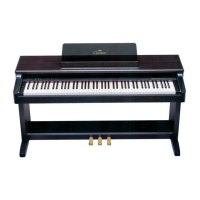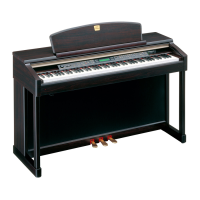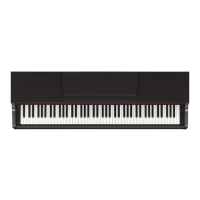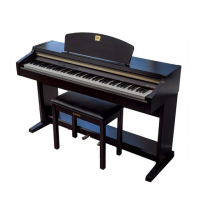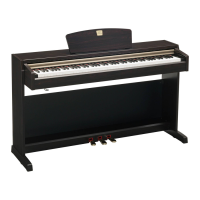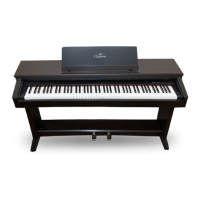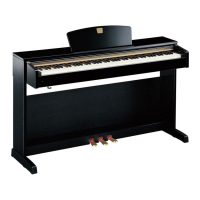Do you have a question about the Yamaha Clavinova CLP-411 and is the answer not in the manual?
Explains safety symbols on the product enclosure, including risk of electric shock.
Covers battery notice, product disposal guidelines, and environmental responsibility.
Covers warranty, specifications changes, servicing, and user responsibility.
Identifies the location of the product's name plate for model and serial numbers.
Highlights the advanced features like AWM tone generation and stereo sampling.
Provides basic instructions for maintaining the instrument's condition and longevity.
Describes the function of various buttons and selectors like POWER, FUNCTION, REVERB, etc.
Explains controls for the built-in metronome, tempo setting, and recording functions.
Details pedal functions and accessory components like the music stand and key cover.
For connecting external audio sources and amplifiers via AUX IN/OUT jacks.
Ports for MIDI data communication and direct computer connection via TO HOST.
For private practice and listening without using internal speakers.
Initial steps including plugging in, powering on, and setting master volume.
How to select voices, use variations, and utilize touch response.
Enhancing sound quality by applying reverb and chorus effects.
How to select and play demo tunes for each voice and piano songs.
Repeating specific phrases within piano songs for practice.
Practice specific parts of songs by muting left or right hand parts.
Synchro Start and Left Pedal control for initiating song playback.
How to play two selected voices simultaneously across the keyboard.
Accessing advanced adjustments like balance, detune, and octave shifts.
Playing different voices with left and right hands by setting a split point.
Adjusting split point, voice balance, and effect depth for split mode.
Choosing from various reverb environments and adjusting the intensity.
Applying chorus for sound animation and depth, and adjusting its intensity.
Explains the purpose and function of each of the three foot pedals.
Matching playing style to HARD, MEDIUM, SOFT, or FIXED response.
Facilitates playing in different keys or matching instruments by shifting pitch.
Fine-tuning the instrument's pitch using keys or the function mode.
Turning the metronome on/off and adjusting its volume.
Adjusting playback and metronome tempo using dedicated buttons.
Initial settings and steps for starting to record music.
Changing initial settings and erasing recorded tracks or all data.
How to listen to recorded performances and adjust playback volume/tempo.
Synchro Start and Left Pedal playback options for controlling playback.
How to navigate and select various functions using the FUNCTION button.
Lists function categories like Dual, Split, Metronome, MIDI, and Backup.
Fine-tuning the instrument's pitch via the function mode for precise intonation.
Choosing from various tuning scales like Equal Temperament or classic tunings.
Adjusting balance, detune, octave shifts for dual voices.
Setting effect depth, slow strings, and resetting dual mode functions.
Adjusting split point, balance, and octave shifts for split voices.
Setting effect depth, damper mode, and resetting split mode functions.
Setting metronome beat signature and volume.
Assigning the left pedal for soft pedal or song start/stop.
Setting the volume for cancelled parts during piano song playback.
Understanding MIDI and initial connections for data transfer.
Setting MIDI transmit and receive channels for selective control.
Managing keyboard control of tone generator and program change messages.
Managing MIDI control messages and transposing MIDI data.
Transmitting current settings and backing up recorder data.
Backing up Voice, MIDI, Tuning, and Pedal settings for preservation.
Direct connection for sequencing and music applications via TO HOST.
Details on cables and interface settings for Mac computers.
Direct connection for sequencing and music applications via TO HOST.
Details on cables and interface settings for IBM PCs.
Diagnosing and fixing issues with audio output and pedal functionality.
Troubleshooting static, radio, TV interference, and distorted sound.
Fixing distorted sound and interpreting internal malfunction display codes.
Restoring the instrument to its original factory preset values.
Information on optional accessories like benches, headphones, and the DOU-10.
Unpacking parts and assembling side, pedal box, and center panels.
Securing the pedal mechanism to the side panels.
Unpacking parts and assembling side panels, feet, and pedal box.
Securing the pedal mechanism to the side panels.
Securing the rear panel to the stand assembly.
Placing and securely attaching the main keyboard unit onto the stand.
Hooking up the pedal cord and adjusting the power input voltage selector.
Ensuring the stand is level and stable by adjusting the foot.
German instructions for connecting the pedal cord to the main unit.
German instructions for adjusting the power input voltage.
German instructions for adjusting the stand's foot for stability.
Steps for attaching the rear panel and positioning the main keyboard unit.
German instructions for installing the rear panel and main keyboard unit.
Spanish/French instructions for installing the rear panel and main keyboard unit.
English instructions for connecting the pedal cord and setting the voltage selector.
English instructions for adjusting the stand's foot for stability.
Details on keys, note polyphony, and available voice selectors.
Information on reverb, touch sensitivity, recorder, and control panel features.
Details on jacks, connectors, amplifiers, speakers, and physical dimensions.
The overall weight of the Clavinova instrument.
List of demonstration pieces categorized by voice type.
List of piano songs provided with their respective composers.
Table summarizing default values for various functions.
Reference table for MIDI system parameters and message changes.
Structure of MIDI data for notes and control messages.
Details on Yamaha-specific MIDI messages and data formats.
Covers basic usage, power cord safety, and proper ventilation.
Addresses electrical safety, plugs, adapters, servicing, and liquid exposure.
Covers placement, water exposure, accessory stability, and hearing protection.
Regulations and compliance information for users in the United States.
Instructions for connecting the power cord according to UK wiring codes.
| Type | Digital Piano |
|---|---|
| Number of Keys | 88 |
| Touch Sensitivity | Hard/Medium/Soft/Fixed |
| Effects | Reverb, Chorus |
| Metronome | Yes |
| MIDI | In/Out/Thru |
| Year Introduced | 1995 |
| Sound Source | AWM (Advanced Wave Memory) |
| Recording | 2-track, 1 song |
| Speakers | 2 x 20W |
| Headphones | 2 |
| Keyboard | GH3 (Graded Hammer 3) |

